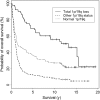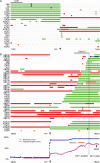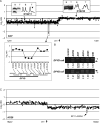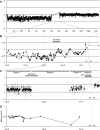Distinct patterns of 1p and 19q alterations identify subtypes of human gliomas that have different prognoses
- PMID: 20164239
- PMCID: PMC2940668
- DOI: 10.1093/neuonc/nop075
Distinct patterns of 1p and 19q alterations identify subtypes of human gliomas that have different prognoses
Abstract
We studied the status of chromosomes 1 and 19 in 363 astrocytic and oligodendroglial tumors. Whereas the predominant pattern of copy number abnormality was a concurrent loss of the entire 1p and 19q regions (total 1p/19q loss) among oligodendroglial tumors and partial deletions of 1p and/or 19q in astrocytic tumors, a subset of apparently astrocytic tumors also had total 1p/19q loss. The presence of total 1p/19q loss was associated with longer survival of patients with all types of adult gliomas independent of age and diagnosis (P = .041). The most commonly deleted region on 19q in astrocytic tumors spans 885 kb in 19q13.33-q13.41, which is telomeric to the previously proposed region. Novel regions of homozygous deletion, including a part of DPYD (1p21.3) or the KLK cluster (19q13.33), were observed in anaplastic oligodendrogliomas. Amplifications encompassing AKT2 (19q13.2) or CCNE1 (19q12) were identified in some glioblastomas. Deletion mapping of the centromeric regions of 1p and 19q in the tumors that had total 1p/19q loss, indicating that the breakpoints lie centromeric to NOTCH2 within the pericentromeric regions of 1p and 19q. Thus, we show that the copy number abnormalities of 1p and 19q in human gliomas are complex and have distinct patterns that are prognostically predictive independent of age and pathological diagnosis. An accurate identification of total 1p/19q loss and discriminating this from other 1p/19q changes is, however, critical when the 1p/19q copy number status is used to stratify patients in clinical trials.
Figures






Similar articles
-
Allelic losses at 1p36 and 19q13 in gliomas: correlation with histologic classification, definition of a 150-kb minimal deleted region on 1p36, and evaluation of CAMTA1 as a candidate tumor suppressor gene.Clin Cancer Res. 2005 Feb 1;11(3):1119-28. Clin Cancer Res. 2005. PMID: 15709179
-
Identification of a novel population in high-grade oligodendroglial tumors not deleted on 1p/19q using array CGH.J Neurooncol. 2012 Sep;109(2):405-13. doi: 10.1007/s11060-012-0909-1. Epub 2012 Jul 24. J Neurooncol. 2012. PMID: 22825724
-
Integrated DNA methylation and copy-number profiling identify three clinically and biologically relevant groups of anaplastic glioma.Acta Neuropathol. 2014 Oct;128(4):561-71. doi: 10.1007/s00401-014-1315-x. Epub 2014 Jul 10. Acta Neuropathol. 2014. PMID: 25008768
-
[Diagnostic and prognostic values of 1p and 19q deletions in adult gliomas: critical review of the literature and implications in daily clinical practice].Rev Neurol (Paris). 2008 Jun-Jul;164(6-7):595-604. doi: 10.1016/j.neurol.2008.04.002. Epub 2008 May 21. Rev Neurol (Paris). 2008. PMID: 18565359 Review. French.
-
Personalized care in neuro-oncology coming of age: why we need MGMT and 1p/19q testing for malignant glioma patients in clinical practice.Neuro Oncol. 2012 Sep;14 Suppl 4(Suppl 4):iv100-8. doi: 10.1093/neuonc/nos206. Neuro Oncol. 2012. PMID: 23095825 Free PMC article. Review.
Cited by
-
MGMT promoter hypermethylation and its associations with genetic alterations in a series of 350 brain tumors.J Neurooncol. 2012 May;107(3):617-31. doi: 10.1007/s11060-011-0787-y. J Neurooncol. 2012. PMID: 22287028
-
Diagnostic and prognostic implications of ribosomal protein transcript expression patterns in human cancers.BMC Cancer. 2018 Mar 12;18(1):275. doi: 10.1186/s12885-018-4178-z. BMC Cancer. 2018. PMID: 29530001 Free PMC article.
-
Prognostic and Predictive Biomarkers in Gliomas.Int J Mol Sci. 2021 Sep 26;22(19):10373. doi: 10.3390/ijms221910373. Int J Mol Sci. 2021. PMID: 34638714 Free PMC article. Review.
-
Genomic changes in gliomas detected using single nucleotide polymorphism array in formalin-fixed, paraffin-embedded tissue: superior results compared with microsatellite analysis.J Mol Diagn. 2011 Sep;13(5):541-8. doi: 10.1016/j.jmoldx.2011.05.009. Epub 2011 Jul 2. J Mol Diagn. 2011. PMID: 21726663 Free PMC article.
-
FoundationOne CDx testing accurately determines whole arm 1p19q codeletion status in gliomas.Neurooncol Adv. 2021 Feb 4;3(1):vdab017. doi: 10.1093/noajnl/vdab017. eCollection 2021 Jan-Dec. Neurooncol Adv. 2021. PMID: 33778493 Free PMC article.
References
-
- Griffin CA, Burger P, Morsberger L, et al. Identification of der(1;19)(q10;p10) in five oligodendrogliomas suggests mechanism of concurrent 1p and 19q loss. J Neuropathol Exp Neurol. 2006;65:988–994. - PubMed
-
- Jenkins RB, Blair H, Ballman KV, et al. A t(1;19)(q10;p10) mediates the combined deletions of 1p and 19q and predicts a better prognosis of patients with oligodendroglioma. Cancer Res. 2006;66:9852–9861. - PubMed
-
- Louis DN, Ohgaki H, Wiestler OD, Cavenee WK. WHO Classification of Tumours of the Central Nervous System. 4th. Lyon, France: International Agency for Research on Cancer; 2007. - PubMed
-
- Cairncross G, Berkey B, Shaw E, et al. Phase III trial of chemotherapy plus radiotherapy compared with radiotherapy alone for pure and mixed anaplastic oligodendroglioma: Intergroup Radiation Therapy Oncology Group Trial 9402. J Clin Oncol. 2006;24:2707–2714. - PubMed
-
- van den Bent MJ, Carpentier AF, Brandes AA, et al. Adjuvant procarbazine, lomustine, and vincristine improves progression-free survival but not overall survival in newly diagnosed anaplastic oligodendrogliomas and oligoastrocytomas: a randomized European Organisation for Research and Treatment of Cancer phase III trial. J Clin Oncol. 2006;24:2715–2722. - PubMed
Publication types
MeSH terms
Grants and funding
LinkOut - more resources
Full Text Sources
Medical
Miscellaneous

